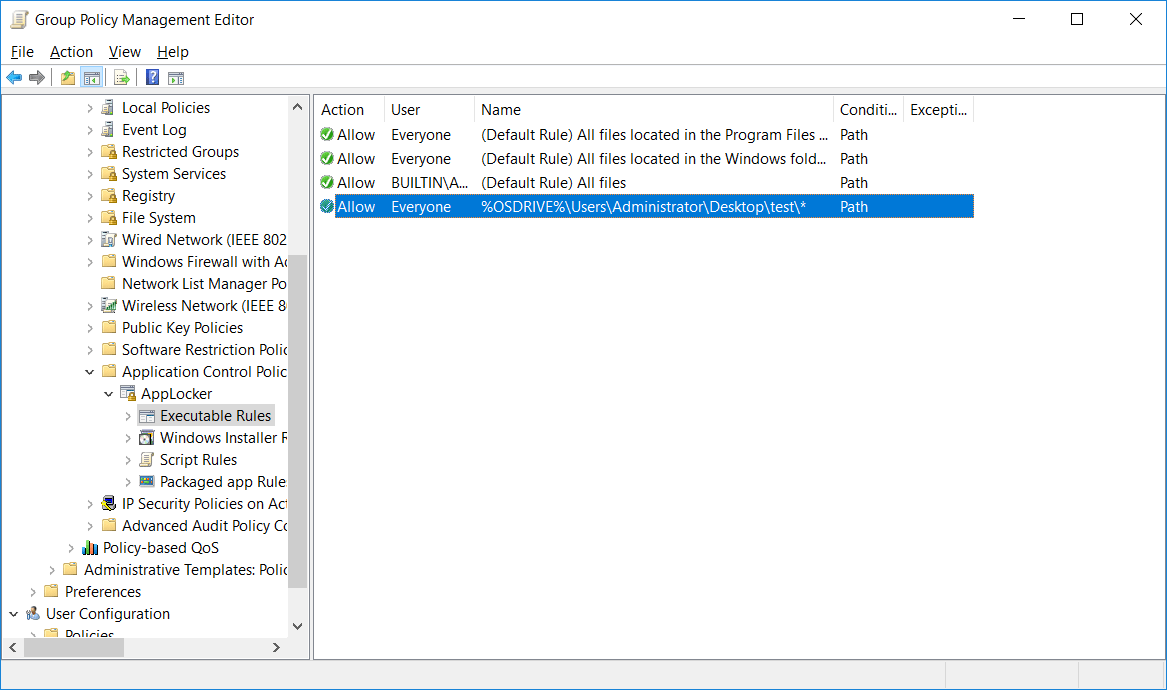
- APPLOCKER GROUP POLICY HOW TO
- APPLOCKER GROUP POLICY WINDOWS 10
- APPLOCKER GROUP POLICY CODE
- APPLOCKER GROUP POLICY DOWNLOAD
WordPad is blocked by AppLocker Deploying AppLocker rules with Group Policy ^ Afterward, try to launch WordPad it should be blocked. It needs to be executed as a system account, and, of course, the execution policy needs to be set to at least remotesigned. New-CimInstance -Namespace $namespaceName -ClassName $className -Property that I modified Sandy's original script by sourcing out the XML policy content to an extra file, which I believe makes it easier to handle. $policyData = Get-Content C:\Applocker_on_Win10pro\exe.xml -raw $parentID = "./Vendor/MSFT/AppLocker/ApplicationLaunchRestrictions/$GroupName" $GroupName = "AppLocker001" #You can use your own Groupname, don't use special characters or with space $className = "MDM_AppLocker_ApplicationLaunchRestrictions01_EXE03" #Do not change this $namespaceName = "root\cimv2\mdm\dmmap" #Do not change this
APPLOCKER GROUP POLICY CODE
In the ISE, paste the following code and save it as Create_Applocker_Exerule.ps1:
APPLOCKER GROUP POLICY DOWNLOAD
You can download psexec, which is a part of PsTools from Microsoft, and extract it to c:\windows. Now open powershell_ISE.exe as system account (!) using the following command on an elevated command prompt: psexec -si powershell_ise Now create a fourth rule that denies access to WordPad ("%ProgramFiles%\Windows NT\Accessories\wordpad.exe") for anyone. Right-click Executable Rules and select Create default rules. It is not the most secure configuration, but for this test, I recommend it. To play it safe for these tests, let us first create the default rules. We start by creating a rule for executables.
APPLOCKER GROUP POLICY WINDOWS 10
Still, we will use it to create the scripts that will be used later to enable AppLocker on Windows 10 Pro and Windows 11 Pro.

The GUI is for enterprise and education edition users only using it on Pro does not enable AppLocker. If you were hoping Microsoft would let you use this built-in GUI, you would be mistaken. cmd, etc.), and packaged apps (modern apps from the Windows Store, including those preinstalled by Microsoft, such as the weather app, calculator, and Paint 3D). Below that, you will see four sections containing governing rules for executables (.exe), Windows installer files (.msi and. I recommend trying this on a virtual machine, which enables you to create and return to snapshots in case you lock yourself out.įirst, open secpol.msc and navigate to Application control policies > AppLocker. Things might look a bit different on Windows 11.ĭisclaimer: If you are unaware, AppLocker is able to render the OS completely unusable when configured incorrectly. Note that all screenshots come from Windows 10 Pro. Honestly, I don't think AppLocker is for the Home edition. Even though Windows 10 Home and Windows 11 Home allow applying these rules, there is no easy way to create these rules for the Window Home edition. You will need Windows 10 Pro or Windows 11 Pro. However, Sandy did not go into detail about the syntax she left us working examples, but she didn't explain how she put them together. Sandy Zeng (Microsoft MVP) seems to be the first who published working scripts.
APPLOCKER GROUP POLICY HOW TO
In fact, you only need to know how to script it. Click OK.It did not take long until someone had a look at the internals and found out that not even MDM licenses were required to make it work.



Learn more about the Windows Defender Application Control feature availability. Some capabilities of Windows Defender Application Control are only available on specific Windows versions.


 0 kommentar(er)
0 kommentar(er)
